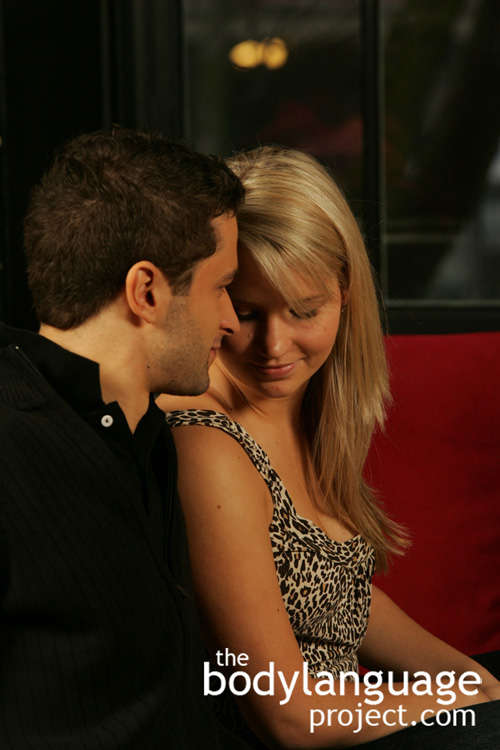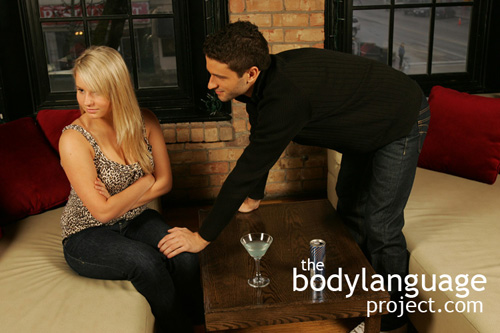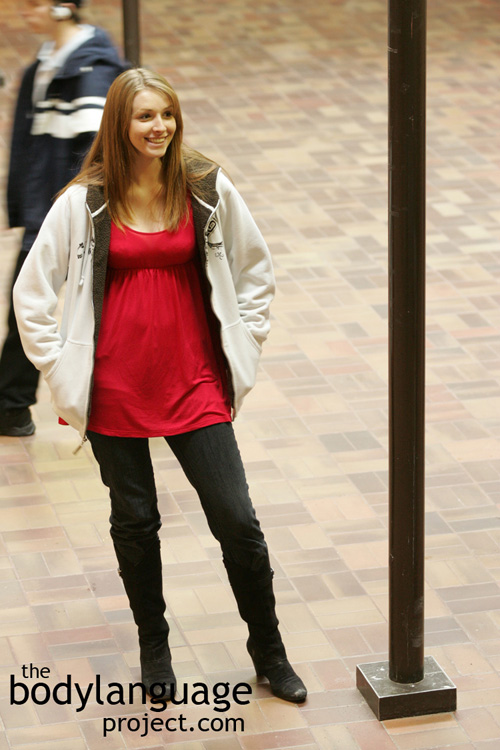Body Language of The Eye Shuttle
Synonym(s): Eyes Flicked Left And Right, Eye Darting, Flicking The Eyes.
Description: A left and right flick of the eyes back and forth while the head remains still.
In One Sentence: Shuttling the eyes back and forth signals uneasiness or a desire to escape.
How To Use it: Use the eye shuttle to tell others that you want to leave by shifting your eyes from them to doorway and back. This can help them speed up the conversation by applying nonverbal pressure. Rather than appearing rude outright, the eye shuttle can tell others the same thing with fewer risks.
Context: General.
Verbal Translation: “If I can find a door, I think I can make an escape so I’m going to flick my eyes around the room until I find a sure thing. I’m going to do it discreetly so I’m not noticed – I’ll keep my head steady and will continue talking and smiling.
Variant: Related to Eye Aversion, Gaze Avoidance and Wandering Eyes, Looking Askance, Shifty Eyes.
Cue In Action: When Dave joined the discussion, Mark began to shift his gaze around the room left and right yet he remained in place, smiling and entertaining the group with his usual jokes. It was obvious that Mark didn’t like Dave all that much and wanted to get out of there.
Meaning and/or Motivation: This is a cue that someone is subconsciously seeking an escape route without trying to be noticed.
Cue Cluster: The eye shuttle will be connected to feigned cues of interest such as smiling, open body language, palm displays and so forth since the motivation behind the cue is to exit the situation covertly (rather than honestly).
Body Language Category: Disengagement, Dislike (nonverbal), Escape movements, Eye Language, Indicators of disinterest (IOD).
Resources:
Allison, T., Puce, A., & McCarthy, G. (2000). Social perception from visual cues: role of the STS region. Trends in Cognitive Neurosciences, 4, 267–278.
Broth, Mathias and Lorenza Mondada. Walking Away: The Embodied Achievement of Activity Closings in Mobile Interaction. Journal of Pragmatics. 2013. 47: 41-58.
http://bodylanguageproject.com/articles/nonverbally-negotiate-conversation-walking-away/
Brooks, C. I., Church, M. A., & Fraser, L. 1986. Effects of duration of eye contact on judgments of personality characteristics. Journal of Social Psychology. 126: 71–78.
Bond, C. F., Kahler, K. N., & Paolicelli, L. M. (1985). The miscommunication of deception: An adaptive perspective. Journal of Experimental Social Psychology, 21, 331–345. doi:10.1016/0022-1031(85)90034-4
Burns, J. A., & Kintz, B. L. (1976). Eye contact while lying during an interview. Bulletin of the Psychonomic Society, 7, 87–89.
Baxter, James C., and Richard M. Rozelle (1975). “Nonverbal Expression as a Function of Crowding During a Simulated Police-Citizen Encounter.” In Journal of Personality and Social Psychology (Vol. 32, No. 1), pp. 40-54.
Davis, Flora (1971). Inside Intuition: What We Know About Nonverbal Communication (San Francisco: McGraw-Hill).
Davis 1978. Camera Eye-Contact by the Candidates in the Presidential Debates of 1976 Source: The journalism quarterly. 55 (3): 431 -437.
Einav, Shiri ; Hood, Bruce M. García Coll, Cynthia (editor). Tell-Tale Eyes: Children’s Attribution of Gaze Aversion as a Lying Cue. Developmental Psychology. 2008. 44(6): 1655-1667.
Ellsworth, Phoebe; Carlsmith, J Merrill. 1973. Eye contact and gaze aversion in an aggressive encounter. Journal of Personality and Social Psychology. 28(2): 280-292.
Friesen, C.K., & Kingstone, A. (1998). The eyes have it: Reflexive orienting is triggered by nonpredictive gaze. Psychonomic Bulletin and Review, 5, 490–493.
George, N., Driver, J., & Dolan, R. J. (2001). Seen gaze-direction modulates fusiform activity and its coupling with other brain areas during face processing. Neuroimage, 13, 1102–1112.
George, N., Driver, J., & Dolan, R. J. (2001). Seen gaze-direction modulates fusiform activity and its coupling with other brain areas during face processing. Neuroimage, 13, 1102–1112.
Gordon, A. K. and A. G. Miller. 2000. Perspective differences in the construal of lies: is deception in the eye of the beholder? Personality and Social Psychology Bulletin 26 (1): 46-55.
Gilliam, Harold V. B.; Van Den Berg, Sjef. 1980. Different Levels of Eye Contact: Effects on Black and White College Students. Urban Education. 15 (1): 83-92.
Goldman. 1980. Effect of Eye Contact and Distance on the Verbal Reinforcement of Attitude. The Journal of social psychology 111(1): 73 -78.
Greene 1979. Title: Need-Fulfillment and Consistency Theory: Relationships Between Self-Esteem and Eye Contact. Source: Western journal of speech communication. 43(2): 123 -133.
Galin, D. and Ornstein, R., 1974. Individual Differences in Cognitive Style – Reflective Eye Movements; Neuropsychologia, 12: 376-397.
Hietanen, J. K. (1999). Does your gaze direction and head orientation shift my visual attention? Neuroreport, 10, 3443–3447.
Horley K, Williams LM, Gonsalvez C, Gordon E (2003) Social phobics do not see eye to eye: a visual scanpath study of emotional expression processing. J Anxiety Disord 17:33–44
Hietanen, Jari. Social attention orienting integrates visual information from head and body orientation. Psychological Research.2002 66(3): 174-179.
Hocking. 1985. Eye contact contrast effects in the employment interview. Communication research reports 2(1): 5-10.
Hemsley, G. D., & Doob, A. N. (1978). The effects of looking behavior on perceptions of a communicator’s credibility. Journal of Applied Social Psychology, 8, 136–144. doi: 10.1111/j.1559-1816.1978.tb00772.x
Jenkins, R., Beaver, J.D., & Calder, A.J. (2006). I thought you were looking at me: Direction-specific aftereffects in gaze perception. Psychological Science, 17, 506–513.
Johansson-Stenmen, O. (2008). Who are the trustworthy, we think? Journal of Economic Behavior & Organization, 68, 456–465. doi:10.1016/j.jebo.2008.08.004
Jenkins, R., Keane, J., & Calder, A.J. (2007, August). From your eyes only: Gaze adaptation from averted eyes and averted heads. Paper presented at the Thirtieth European Conference on Visual Perception, Arezzo, Italy.
Kawashima, R., Sugiura, M., Kato, T., Nakamura, A., Hatano, K., Ito, K., Fukuda, H., Kojima, S., & Nakamura, K. (1999). The human amygdala plays an important role in gaze monitoring: A PET study. Brain, 122, 779–783.
Kaminski, Juliane ; Call, Josep ; Tomasello, Michael. Body orientation and face orientation: two factors controlling apes’ begging behavior from humans. Animal Cognition. 2004. 7(4): 216-223.
Kinsbourne, M., 1972. Eye and Head Turning Indicates Cerebral Lateralization; Science, 179: 539-541.
Kocel, K., et al.,1972. Lateral Eye Movement and Cognitive Mode; Psychon Sci. 27: 223-224.
Knackstedt, G., & Kleinke, C. L. (1991). Eye contact, gender, and personality judgments. Journal of Social Psychology, 131: 303-304.
Konopacki 1987. Eye Movement Betrays a Prospect’s Inner Feelings Source: Marketing news 21(10): 4.
Lance, Brent ; Marsella, Stacy. Glances, glares, and glowering: how should a virtual human express emotion through gaze? Autonomous Agents and Multi-Agent Systems, 2010. 20(1): 50-69
Langer, Julia and Rodebaugh, Thomas. Social Anxiety and Gaze Avoidance: Averting Gaze but not Anxiety. Cognitive Therapy and Research, 2013, Vol.37(6): 1110-1120.
Langton, S.R.H. (2000). The mutual influence of gaze and head orientation in the analysis of social attention direction. Quarterly Journal of Experimental Psychology A: Human Experimental Psychology, 53, 825–845.
Langton, S. R. H., & Bruce, V. (1999). Reflexive visual orienting in response to the social attention of others. Visual Cognition, 6, 541–567.
Langton, S. R. H., & Bruce, V. (2000). You must see the point: Automatic processing of cues to the direction of social attention. Journal of Experimental Psychology: Human Perception and Performance, 26, 747–757.
Montgomery, Derek ; Moran, Christy ; Bach, Leslie. The influence of nonverbal cues associated with looking behavior on young children’s mentalistic attributions.
Journal of Nonverbal Behavior. 1996. 20(4): 229-249.
Mobbs, N.A. 1968. Eye-contact in Relation to Social Introversion-Extraversion. British Journal of Social Clinical Psychology 7: 305-306.
Matsuda, Yoshi-Taka ; Okanoya, Kazuo ; Myowa-Yamakoshi, Masako. Shyness in early infancy: approach-avoidance conflicts in temperament and hypersensitivity to eyes during initial gazes to faces. PloS one. 2013 8(6): pp.e65476
Moukheiber A, Rautureau G, Perez-Diaz F, Soussignan R, Dubal S, Jouvent R, Pelissolo A (2010) Gaze avoidance in social phobia: objective e measure and correlates. Behav Res Ther 48:147–151
Mccarthy, Anjanie ; Lee, Kang. Children’s Knowledge of Deceptive Gaze Cues and Its Relation to Their Actual Lying Behavior. Journal of Experimental Child Psychology. 2009. 103(2): 117-134.
Mann, Samantha ; Ewens, Sarah ; Shaw, Dominic ; Vrij, Aldert ; Leal, Sharon ; Hillman, Jackie. Lying Eyes: Why Liars Seek Deliberate Eye Contact. Psychiatry, Psychology and Law. 2013. 20(3): 452-461.
Navarro, Joe. 2008. What Every BODY is Saying: An Ex-FBI Agent’s Guide to Speed-Reading People. William Morrow Paperbacks.
Puce, Allison, T and McCarthy, G. (2000). Social perception from visual cues: role of the STS region. Trends in Cognitive Neurosciences, 4, 267–278.
Perrett, D.I., Hietanen, J.K., Oram, M.W., & Benson, P.J. (1992). Organization and functions of cells responsive to faces in the temporal cortex. Philosophical Transactions of the Royal Society of London B: Biological Sciences, 335, 23–30.
Ponari, Marta ; Trojano, Luigi ; Grossi, Dario ; Conson, Massimiliano. “Avoiding or approaching eyes”? Introversion/extraversion affects the gaze-cueing effect. Cognitive Processing. 2013. 14(3): 293-299.
Rutter, D.C; D. C. Pennington, M. E. Dewey and J. Swain. 1984. Eye-contact as a chance product of individual looking: Implications for the intimacy model of Argyle and Dean. Source: Journal of nonverbal behavior. 8(4): 250-258.
Richard Tessler and Lisa Sushelsky. 1978. Effects of eye contact and social status on the perception of a job applicant in an employment interviewing situation. Journal of Vocational Behavior 13(3): 338-347.
Riggio, R. E., & Friedman, H. S. (1983). Individual differences and cues to deception. Journal of Personality and Social Psychology, 45, 899–915. doi: 10.1037/0022-3514.45.4.899
Stern, Daniel and Estelle Bender (1974). “An Ethological Study of Children Approaching a Strange Adult.” In Richard Friedman et al. (Eds.), Sex Differences in Behavior (New York: John Wiley and Sons), pp. 233-58.
Slessor, Gillian ; Phillips, Louise H. ; Bull, Rebecca ; Venturini, Cristina ; Bonny, Emily J. ; Rokaszewicz, Anna. Investigating the “deceiver stereotype”: do older adults associate averted gaze with deception?(Author abstract). The Journals of Gerontology, Series B. 2012. 67(2): 178(6).
Sporer, S. L., & Schwandt, B. (2007). Moderators of nonverbal indicators of deception: A meta-analytic synthesis. Psychology, Public Policy and Law, 13, 1–34. doi: 10.1037/1076-8971.13.1.1
Sitton, Sarah C; Griffin, Susan T. 1981. Detection of deception from clients’ eye contact patterns. Journal of Counseling Psychology. 28(3): 269-271.
Straube, Benjamin ; Green, Antonia ; Jansen, Andreas ; Chatterjee, Anjan ; Kircher, Tilo. Social cues, mentalizing and the neural processing of speech accompanied by gestures. Neuropsychologia. 2010. 48(2): 382-393.
Straube, Thomas ; Langohr, Bernd ; Schmidt, Stephanie ; Mentzel, Hans-Joachim ; Miltner, Wolfgang H.R. Increased amygdala activation to averted versus direct gaze in humans is independent of valence of facial expression. NeuroImage. 2010 49(3): 2680-2686.
Tomasello, M., Hare, B., Lehmann, H., & Call, J. (2007). Reliance on head versus eyes in the gaze following of great apes and human infants: The cooperative eye hypothesis. Journal of Human Evolution, 52, 314–320.
Vrij, A., Harden, E, Terry, J., Edward, K., & Bull, R. (2000). The influence of personal characteristics, stakes and lie complexity on the accuracy and confidence to detect deceit, in R. Roesch, R.R. Corrado, & R. J. Dempster (Eds.), Psychology in the courts: International advances in knowledge. Amsterdam: Harwood Academic.
Vrij, A., & Semin, G. R. (1996). Lie experts’ beliefs about nonverbal indicators of deception. Journal of Nonverbal Behaviour, 20, 65–81. doi: 10.1007/BF02248715
Wicker, B., Michel, F., Henaff, M.-A., & Decety, J. (1998). Brain regions involved in the perception of gaze: A PET study. Neuroimage, 8, 221–227.
Wirth, James H ; Sacco, Donald F ; Hugenberg, Kurt ; Williams, Kipling D. Eye gaze as relational evaluation: averted eye gaze leads to feelings of ostracism and relational devaluation. Personality & social psychology bulletin. 2010 36(7): 869-82.










